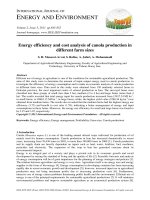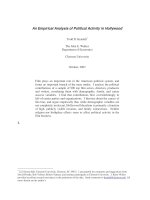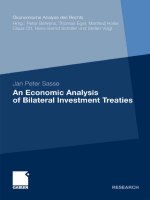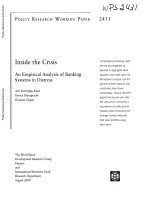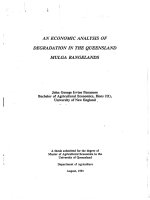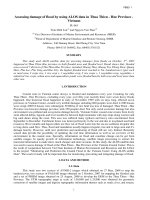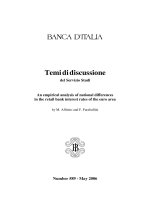AN ECONOMIC ANALYSIS OF GINGER PRODUCTION IN THUY BIEU WARD, THUA THIEN HUE PROVINCE
Bạn đang xem bản rút gọn của tài liệu. Xem và tải ngay bản đầy đủ của tài liệu tại đây (1.21 MB, 73 trang )
HUE UNIVERSITY
COLLEGE OF ECONOMICS
THE ADVANCED PROGRAM
UNDERGRADUATE THESIS
AN ECONOMIC ANALYSIS OF GINGER
PRODUCTION IN THUY BIEU WARD, THUA
THIEN HUE PROVINCE
NGUYEN KHANH VAN
Academic year 2011 - 2016
HUE UNIVERSITY
COLLEGE OF ECONOMICS
THE ADVANCED PROGRAM
UNDERGRADUATE THESIS
AN ECONOMIC ANALYSIS OF GINGER
PRODUCTION IN THUY BIEU WARD, THUA
THIEN HUE PROVINCE
Name of student: Ms. Nguyen Khanh Van
Class: K45 Agricultural Economics – Finance
Academic year: 2011 - 2016
Hue, June 2016
Name of supervisor:
Assoc. Prof. Dr. Bui Dung The
ACKNOWLEDGEMENTS
First of all, I would like to express sincere and profound gratitude to my
supervisor Assoc. Prof. Dr. Bui Dung The for his enthusiastic supervision during
roughly three months of working on the thesis. Without his help, I would never
complete my undergraduate thesis.
I would also like to thank all office staffs in Thua Thien Hue Department of
Agriculture and Rural Development as well as all officers in Thuy Bieu Cooperative
their enthusiastic help on searching necessary data for my research.
Grateful acknowledgement goes to ginger households in Thuy Bieu Ward in
Thua Thien Hue province, who were willing to participate in my survey, they treated
me so well and kindly during the interview even though weather was extremely hot
and they were very exhausted after working for hours under the sun. I had many
unforgettable memories with them within nearly twenty days doing interview and I
truly love and miss them so much.
I would like to save my last gratitude for my family and my friends, I owe
them everything and they mean the world to me. I would never reach this point
without their unconditional and immeasurable love. I am absolutely indebted to their
sacrifices and I love them more than words.
Nguyen Khanh Van
Hue, May 2016
3
TABLE OF CONTENTS
ABBREVIATIONS
HA
: Hectare
GP
: Gross Production value
GM
: Gross margin
OLS
: Ordinary Least Squares
TB
: Thuy Bieu Ward
TC
: Total cost
TTH
: Thua Thien Hue Province
VND
: Vietnamese dong
1.
4
LIST OF TABLES
Table 1.1: Nutrition Facts of ginger.................................................................................8
Table 1.2: Top Five Ginger Producing Countries..........................................................16
Table 2.1: The economic structure of Thuy Bieu from 2014 to 2015...........................20
Table 2.2: Total production value of Thuy Bieu (2013-2015)......................................21
Table 2.3: The population and labor of TB in 2015.......................................................22
Table 2.4: The situation of using land in TB (2013-2015)............................................23
Table 2.5: Planting area and value of ginger production in TB (2013-2015)................27
Table 2.6: Age and Experience of ginger farmers.........................................................30
Table 2.7: Socio-economic characteristics of sample respondents................................32
Table 2.8: The situation of planting area........................................................................33
Table 2.9: Input cost of ginger production.....................................................................34
Table 2.10: Seed selection of household........................................................................35
Table 2.11: Fertilizer usage of households.....................................................................36
Table 2.12: Detailed cost of Ginger production.............................................................37
Table 2.13: Yield of Ginger production.........................................................................39
Table 2.14: Economic target of Ginger production.......................................................39
Table 2.15: Effects of planting area to Ginger production............................................44
Table 2.16: Effects of costs to Traditional Ginger production ....................................45
Table 2.17: Effects of costs to In Bag Ginger production ...........................................45
Table 2.18: Estimates of the stochastic Cobb-Douglas frontier production function and
technical inefficiency model for ginger..........................................................................48
5
6
ABSTRACT
The purpose of this thesis was to describe the economic analysis of ginger
production in Thuy Bieu Ward, Thua Thien Hue Province. The thesis's research
design was quantitative and descriptive. Farmers in Thuy Bieu Ward who have been
planting ginger with kept records in their production during 2013-2015 became the
thesis's population. The unit of measurement was defined as Vietnamese. Analysis of
the 60 qualifying surveys took the form of descriptive statistical calculations and
economic modeling in Cobb-Douglass, a production function. The function in Cobb–
Douglas production is widely used to represent the technological relationship between
the amounts of inputs, particularly physical labor, seed, fertilizer, agrochemical and
others (materials, loan…) and the amount of output of ginger that can be produced by
those inputs. In the end, the total thesis output effect from these factors was summed
and extracted to describe the effect of farmer investments on the ginger production.
The study provided documentation to support the experiential planning mission of
agricultural development. As an average result of the VND 425,352 of gross
production value, VND 218,029 of farmer total cost, an estimated total profit for the
production equaled VND 207,323. It is important to 2 notes that the majority of the
thesis's impact came from the effect of the scale of production and the assumptions
made about farmer spending. The thesis revealed a 1.95 output multiplier; it meant
each new VND spent by farmers, a VND 0.95 of product value was created. The
findings are consistent with other related economic researches and demonstrations on
the region's economy. Implications suggest a need for increased support of local
authorities and other work-based agricultural encouragement programs. A number of
practices, including stronger emphasis on promoting economic acumen of farmers and
greater accuracy of recordkeeping, could be instituted. Following thesis
recommendations could result in increased farmer participation in work-based
knowledge improving and additional economic impact for Thuy Bieu’s economy.
7
Farmers with these opportunities are more likely to possess skills, ready to meet
demands of a growing global economy.
8
PART I. INTRODUCTION
1. Statement of Problem
Thua Thien Hue province which is in the North Central is strongly influenced by the
humid tropical monsoons climate. Soil is very diversified and distributed on a variety
of terrains. However, the area of land for annual crop is small about 59,143.29
hectares, accounting for 15.35% the area of agricultural land, which makes farmers’
income unstable because of heavy dependence on rice and perennials. Dealing with
this situation, in recent years all levels of the province has made great efforts in
restructuring plants, creating suitable alternative plants which have high economic
value, meet the demands of the market and increase famers’ income.
Ginger is the one of the most important and most widely used spices worldwide. Due
to its universal appeal, ginger has spread to most tropical and subtropical countries
from the China-India region, where ginger cultivation was prevalent probably from the
days of unrecorded history. In ancient time, ginger was more valued for its medical
properties and played an important role in primary health care in India and China.
Ginger has been grown for long time in Hue city as a spice plant serving the needs of
the family. Through many years of cultivation, ginger proved to be quite easy to grow
and suitable to cultivation conditions here. Thuy Bieu which is a ward of Hue city has
a lot of households growing ginger for long time. According to the Agricultural cooperative of this ward, I know the majority of farmers planting ginger in traditional
method which means growing ginger in land so it is difficult to care and prevent
diseases and disasters. On the other hand, Thuy Bieu ward covers a large area land of
perennials especially Thanh Tra pomelo tree. The development of Thanh Tra pomelo
plants has brought huge economic efficiency to the local and contributed to change the
rural face of Thuy Bieu in recent years. However, the Thanh Tra pomelo tree is
perennial with five year period from planting until the first harvest, so it is big waste
for a fertile alluvial area here during that period when the soil is idle. From this reality,
9
farmers of Thuy Bieu ward actively found out a new ginger method using more kinds
of seedlings with high economic efficiency for intercropping in order to utilize idle
land area under Thanh Tra plants. Recently model of growing ginger proved to be a
new and effective one in many parts of our country. Realizing the potential of this
model on the ward area, The Agricultural co-operative bravely piloted in the local and
initially obtained positive results. However, farmers here are still quite unassertive due
to long production practices and fear of no output.
Through research, I find it necessary to apply my knowledge gained from the
University for helping farmers here see the opportunity from ginger then they can get
suitable production directions to solve the existing problems in the production
situation here. In the final course internship, I was given a chance to visit the local by
my university for grasping the specific situation so I decided to choose the theme: "An
economic analysis of ginger production in Thuy Bieu Ward, Thua Thien Hue
Province". According to this research, I hope to contribute partially for providing give
the local authority and people useful supporting information to get proper production
direction in the future.
2. Objective of Research
2.1
General objective:
Under these circumstances, the principal purpose of the thesis is analyzing of
economic of ginger production in Thuy Bieu ward, Hue province. According to the
research’s results to put forward proposed solutions to improve the economics of
ginger production, as well as promoting the consumption and production of ginger in
Hue.
2.2
Specific objective
There are three specific objectives which will be resolved and fulfilled clearly
throughout three main parts of the thesis. In the first part, the thesis aims to describe
10
ginger situation in TB Ward in overall as well as general problems leading to
implementation of the research.
In the second part, firstly, the objectives are all issues related to ginger such as history,
allocation, values, production situation and consumption situation over the world as
well as Viet Nam. Secondly, how the characteristics of TB Ward and households that
researched what the results and economic values of ginger in Thuy Bieu Ward, Hue
City is. Thirdly, it estimates how factors that affect production efficiency of ginger In
addition, some measures are considered to improve the efficiency in the studied site.
Lastly, the objective is set to point recommendations for local ginger farms, as
well as local authorities in the third part.
3. Scope of Research
Scope of space: Research in TB Ward, Hue. Focus on ginger farmers in Thuy Bieu
ward.
Time range: Secondary data collected from 2013-2015. Primary data collected by
questionnaire in morning (9 AM - 11 AM) and afternoon (16 PM - 19 PM); the survey
was conducted from 20th April 2016 to 10th May 2016 until achieving the number of
needed samples.
Scope of content: An economic analysis of ginger production in Thuy Bieu Ward,
Thua Thien Hue Province and proposing a number of solutions to develop ginger
production in the future.
4. Research Methodologies
4.1
Secondary data collection
Secondary data was collected from the relevant previous research in the world and in
Vietnam in order to synthesize information and data from the report on ginger
production and its economic efficiency. Besides that, secondary data used for this
research were also collected from various sources including relevant books borrowed
from Hue College of Economics library, previous researches, Journals, Articles and
11
other sources on the internet such as annual report, forums, and blogs and so on. This
helps the researchers to save time and minimize cost. Some information on this paper
was translated in to English by the translation tools and be rephrased by the authors so
as to remain the closest meaning of the content from the original language.
4.2
Primary data collection
An advantage of using primary data is that researcher is collecting information for the
specific purposes of study. In essence, the questions the researcher asks are tailored to
elicit the data that will help them with their study. Researchers collect the data
themselves, using surveys, interviews and direct observations. The primary data is
surveyed through a structured questionnaire to collect detailed information from 60
interviewed households in Thuy Bieu ward on various aspects of ginger production
such as input (seed, irrigation, fertilizer, …), output of ginger, price of ginger or ginger
seed and factors affecting production. Based on the primary data collected, data will be
processed and analyzed to achieve a specific objective is assessment on economic
analysis of ginger production in Thuy Bieu ward.
Questionnaire:
The questionnaire is the set of questions framed for the specific purpose of data
collection through field work. First, it translates the objectives of the field work into
specific questions which help in the collection of necessary data such as age, farming
experience, level of education, cost of ginger production, input materials of ginger
production, land situation, ginger price...The second purpose of questionnaire is to
assist interviewer in motivating the respondent to communicate the required
information. The quantity and quality of data collected depends largely on the nature
of questionnaire. The form of questionnaire depends upon some of the factors such as
willingness of the respondents, usefulness of the information and its level, language,
sequence of questions, single idea and so on. Hence, I used types of question in the
questionnaire as qualitative questions, quantitative questions, contingency questions
and closed-ended questions (two-point questions).
12
Sampling method:
The research used Cochran formula for calculating sample size:
z 2 .( p.q )
n=
e2
where p = q= 0.5 ; the error term e = 15%, significant level of 95% (z = 1.96)
Sample size is :
n=
z 2 .( p.q )
e2
1,962 × 0,5 × 0,5
0,152
=
43
Scale of study has 6 variables observed and the sample size required is 43 samples. So,
author delivered 60 questionnaires and obtained 60 valid results to investigate surely.
The technique of “disproportionate stratified sample” would be used for drawing a
random sample from primary data on characteristics of the households planting ginger
in the Thuy Bieu resettlement area. To conduct a disproportionate stratified sample,
the population of sampling units are divided into two groups including households
growing traditional method and households growing in-bag method. I surveyed a
sample of 30 households growing traditional method and 30 households growing inbag method is to be selected from ginger household in TB with over 150 households
planting ginger.
Interview methods:
The author use personal interview method which is a face to face communication
between the interviewer and the respondents. Generally the personal interview is
carried out in a planned manner and is referred to as ‘structured interview’ (rapport
building, introduction, recording and closing). Surveys were conducted with prepared
questions.
4.3
Data analysis
Method of descriptive statistics
13
The descriptive statistic is combination of measurement, description and presentation
of the data. The aim of descriptive statistical analysis is to provide the important
characteristics of the respondents (ginger growers) such as age, sexual, education
level, production experience and examine and describe some of the variable,
particularly the amount of seeds, muck, fertilizers and pesticide and so on by using
simple statistical analysis as average, variance, range, maximum and minimum values
of the variables. Methods of information and data analysis: statistical methods,
comparative, analytical and integrated methods and multiple regression models by
using the Excel and Eview software program.
Method of Regression Analysis
Regression analysis is used in applied agricultural economics research with two main
purposes, which are forecasting and making statistical inferences about the effect of
exogenous variables on the dependent variable. In economics, the Cobb–Douglas
production function is a particular functional form of the production function, widely
used to represent the technological relationship between the amounts of two or more
inputs and the amount of output that can be produced by those inputs. The stochastic
Cobb-Douglas production frontier model was used for estimating technical efficiency
of ginger producer in the study areas and the model is given below:
Y=AX1 β1 X2 β2 X3 β3 X4 β4 X5 β5eβ6X6
Take the natural logarithm above function:
lnY = ln A + β1 ln X1 + β2 ln X2 + β3 ln X3 + β4 ln X4 + β5 ln X5 + β6 X6 (*)
This is the original Cobb-Douglas production function.
In
=
the
natural
logarithm
A= Intercept
β1 – β5 = Regression coefficient or Parameters to
Y = Output
be estimated.
X1,2,3… = Input factors
β6 = unknown parameters to be estimated
14
PART II: RESEARCH CONTENTS AND RESULTS
CHAPTER 1: THEORETICAL FRAMEWORK AND EMPIRICAL
FRAMEWORK OF THE RESEARCH
1.1 THEORETICAL FRAMEWORK
1.1.1 Characteristics of ginger
a. Origin and distribution of ginger
Ginger (Zingiberofficinale) is a flowering plant in the family Zingiberaceae whose
rhizome, ginger root or simply ginger, is widely used as a spice or a folk medicine.
Tropical areas having high rainfall and hot and humid weather conditions are
favorable for Ginger. The name ‘ginger’ is derived from the Sanskrit word
“Srngaveram” which means ‘horn root’. It is a herbaceous perennial which grows
annual stems about a meter tall bearing narrow green leaves and yellow flowers...
Ginger originated in the lush tropical jungles in Southern Asia. In South East Asia, the
most popular form of ginger is raw ginger. It is revered as one of the most important
and valued spices of the world. For over 5000 years ginger has been recognized as the
“universal medicine” by the ancient oriental of China and India. Although ginger no
longer grows wild, it is thought to have originated on the Indian subcontinent. The
ginger plants grown in India show the largest amount of genetic variation. In Vietnam,
ginger is grown quite popular but households only grow on a small scale with fewer
yields that provides mainly the local and domestic market.
b. Characteristics of ginger
Ginger is herbaceous perennial which grows annual stems about 0.6-1 meter tall. The
part of ginger that's used most often is the root. Ginger root is beige in color with a
knotted, rough appearance. The part of the plant above the ground is a foot long
upright stem with long, narrow leaves. The leaves are green and ribbed in texture.
15
Ginger flowers are small and white or yellow-green in color. The useable part of the
root is a rhizome, which is how the plant propagates itself.
Ginger is widely cultivated in tropical climates with the annual average temperature of
21-270C, annual average rainfall of 1500-2500mm. That is a reason why the south of
Viet Nam is suitable for growing ginger. The ginger needs quality and thick land that
is able to hold and drain water flexibly, the best land is rich soil and the worst one is
sandy or clay soil. Ginger is appropriate for land with pH=4-5.5 but the strongest
development in pH=5.5-7. Ginger is the preferred humidity but not flooding the root, it
also needs an amount of N, P and K fertilizer relatively high.
1.1.2 Values of ginger
a.
Nutrition value of ginger
Primarily a spice, Ginger root is commonly used in Asian cuisine, baked goods and
beverages. As a seasoning, ginger root provides a spicy and pungent flavor to foods,
but is not a significant source of nutrition. However, it does provide trace amounts of
certain vitamins and minerals.
Table 1.1: Nutrition Facts of ginger
(Per 100g of ginger)
Nutrition Facts
Calories
Carbohydrate
- Sugar
- Dietary Fiber
Fat
Protein
Vitamin A
Vitamin C
Phosphor
Iron
Fresh ginger
333 kJ (80 kcal)
17,77 g
1,70 g
2,0 g
0,75 g
1,82 g
0 IU
5.0 mg (6%)
34 mg (5%)
415 mg (9%)
Dried ginger
1.404 kJ (336 kcal)
71,62 g
3,39 g
14,1 g
4,24 g
8,98 g
30 IU
0.7 mg (1%)
168 mg (24%)
1320 mg (28%)
Source: USDA National Nutrient Database for Standard Reference
16
b. Medicinal value of ginger
Because it contains amounts of fiber, essential vitamins and minerals, raw ginger root
is used both in cooking and in herbal medicine. According to the University of
Maryland Medical Center, ginger root is used medicinally to treat a range of disorders
including motion sickness, nausea and vomiting associated with pregnancy,
chemotherapy treatment and post-surgical recovery, chemotherapy and inflammatory
illnesses.
c. Industrial value of ginger
Ginger is not used for spice but also industry such as ginger oil, ginger
cream,...Ginger oil is extracted by steam distillation from the root of the plant. It is
used for its antiseptic, aphrodisiac, laxative, stimulant and tonic properties and is
often blended with other essential oils to produce many different mixtures for many
different ailments. Ginger oil has a spicy and peppery aroma.
It also has a history in the perfume industry and is considered to have an oriental
note to it. Ginger oil is widely used in the food industry. It may be added to a blend
to be diffused into the air, or to a carrier oil and rubbed on the earlobes, temples, or
base of the neck. It is used in burners and vaporizers, in bath, blended in base cream,
and in hot compress.
d. Economic value of ginger
Ginger is basically in spice that using for cooking as well as medicines in alternative
medicines and industry such as crystallized ginger, ginger tea, ginger oil…those are
productions of ginger to serve people’s life. Growing ginger is developing day by day.
Many farmers become rich and have comfortable life as relying on ginger production.
For example, Mr Le Van Man( An Hoa A, Ba Chuc town, An Giang Province) had
farming experience of 10 years , said that:” Ginger cultivation must be complied with
techniques of cultivation. If ginger growers do that and work hard, they will have
17
stable life. My family has 4000 m2 for growing ginger. We can harvest 6-7 tones/1000
m2. Ginger is sold at 26,000 VND/kg. If we give our mine to improving production ,
prevention and control diseaes, we profit about from 130 millions VND to 180
millions VND from ginger cultivation. It means that we minused total cost.”
Thus, ginger in our country has high economic value. It is grown everywhere and
suitable for natural conditions of TTH. It is a one of plants bringing high incomes to
people completely.
1.1.3 The factors affecting the production of ginger
a. Natural factors
- Soil type and quality: Soil is the fundamental resource base for all agricultural production
systems. Soil type refers to the physical composition or properties of the soil. Soils
consist of decomposed mineral matter (sand, silt, and clay) and decomposed organic
matter. Optimum ginger production is achieved on well-drained loam soils. Although
ginger can be grown on a wide range of soil types, most ginger are not well adapted to
clay and sandy soil types. Soils of this type tend to have poor aeration and drainage and
can restrict root growth. In ginger production, soil health is essential. Soil quality
influences its ability to provide an optimum media for growth; sustain crop productivity
and maintain environmental quality. Therefore, soil quality and soil health are viewed as
the foundation to successful ginger production.
- The weather and climate: there are varieties of weather and climate factors effect on
ginger production such as light, air moisture, temperature, rainfall…
b. Social-economic factors
- Labor: Labor is the effort that people contribute to the production of goods. Ginger
production process mainly conducted in manual methods, particularly in the
prevention and control on diseases. The reasonable use labor is an effective on using
of resources and leisure time.
- Capital: Think of capital as the machinery, tools and buildings humans use to produce
goods. Ginger is a short-term plant and its production cost quite low compare to
18
other plants. The existing time of ginger is only about from six months to 12 months
so payback period is also brief.
- Facilities: in order to produce ginger efficiently, we must build a good transportation
system and watering system. Besides that, a consumption network is also needed.
- Market: the current demand is increasing with high requirements in quality, design and
form ... so market research is always an issue of concern for ginger farmer and local
authorities.
c. Technical factors
- Seed: High-quality seed is vital to the production of a successful yield and therefore
careful selection of planting material is required—special care is taken in selecting
material free of pest and disease. Ginger is mainly grown by maintaining seed of
ginger the previous crop.
- Fertilizer: Large amounts of fertilizer inputs throughout the production cycle are required
to ensure high yields. It is common practice for growers to use a range of fertilizers—
including poultry manure, sawdust, urea, phosphate, potassium nitrate or (N, P, K)
fertilizer —twice in the season (before planting and once the field has germinated) to
boost nutrient levels in the soil and accelerate plant growth.
- Water and irrigation: Ginger is a subtropical crop requiring large amounts of goodquality water to maintain rapid growth. On average, a ginger crop requires
approximately 2.5 mega liters per hectare of water and growers need provide water
fully.
- Managing pests and diseases: Pests and diseases pose the largest production concern
to most ginger growers and are a constant threat to yields. All growers anticipate
some losses every season due to disease. The most common disease threats are
Fusarium yellow rot and root-knot nematode. Hence, ginger growers have to use
chemicals throughout the production cycle to combat pests and diseases.
1.1.4 Methods of ginger cultivation
a. Growing ginger with tradition method
19
Depending on altitude and rainfall, planting is done from early spring (JanuaryFebruary) and goes up to end of spring (April - May). The rhizomes are planted in 2-3
rows in the beds and covered with soil. The land should be ploughed three to four
times thoroughly with receipt of early summer showers to bring the soil to the fine
farmyard. Three to four crosswise harrowing should be given to make soil loose and
friable. Beds of about 1 meter width, 15 cm height and of convenient length should be
prepared with an inter-space of 50 cm in between beds. In the case of irrigated crop,
ridges are formed 40 cm apart. Selecting a planting material is important in ginger
farming. Healthy rhizomes free from diseases and pets should be selected. While
selecting, make sure rhizomes are broken into pieces keeping two to three sprouted eye
buds on each rhizome. Also make sure that each piece is 2.5 cm to 5 cm long and 20
grams to 25 grams in weight. When ginger is intercropped with other crops inter-row
distance is generally kept at wide 60-90 cm.
b. Growing ginger with in-bag method
The selecting seed on growing ginger in bags is the same way with traditional method.
Basically, they have different cultivation method. The poly bags can be found easily at
agricultural equipment stores or plastic stores or can be reused by old bags and are
available in various sizes depending on people’s needs. Thus, the poly bags are
relatively cheap. The uniqueness of the in bag model can take advantage of all spaces
such as outside the fence, under trees, along the walkway or flat surfaces to put bags.
Before putting the plant inside the poly bags, you need to create holes on the right and
left sides of the plastics. The holes function as water disposal unit thereby adjusting
the soil moisture level. Ginger planting seeds in sacks or plastic bag should carefully.
Make the hole as big as the size of the plastic bag seedlings, put ginger seed into the
planting hole, then cover with the surrounding medium and condense moderation.
After planting, the seeds should be watered with water so that the plants get enough
water.
1.1.5 Economic criteria
20
Efficiency is concerned with the optimal production and distribution or these scarce
resources. The economic efficiency includes productive efficiency and allocation.
Productive efficiency is concerned with producing goods and services with the optimal
combination of inputs to produce maximum output for the minimum cost. Allocation
efficiency occurs when there is an optimal distribution of goods and services, taking
into account consumer’s preferences. There are criteria that are often shows the
economic efficiency.
-
Gross production value: Gross rate of production value is the total rate of return
on an investment before the deduction of any fees or expenses. The gross rate of
production value is quoted over a specific period of time, such as a month, quarter
-
or year.
Total production cost: The total cost of production and is made up of variable
costs, which vary according to the quantity of a good produced and include inputs
such as labor and raw materials, plus fixed costs, which are independent of the
quantity of a good produced and include inputs (capital) that cannot be varied in
-
the short term, such as buildings and machinery.
Gross Margin: is a net sale less the cost of goods sold. The gross margin reveals
the amount that an entity earns from the sale of its products and services, before the
-
deduction of any selling and administrative expenses
Cash cost: Cash cost is a cash basis accounting cost recognition process that
classifies costs as they are paid for in cash.
1.1.6 Modeling Research
a. The related researches
Some studies about economic analysis of ginger and factors affect the ginger
production have been made around the world. Research (June 2015) in Sirmour
district of Himachal Pradesh, India was conducted with the objective to evaluate the
socio-economics of ginger growers such as household composition, educational status,
occupational status, cropping pattern and cropping intensity, benefit cost ratio, factors
affecting productivity of ginger crop(seed, input issues, agronomic issues, marketing
issues...) and strongly suggested the strengthening of R&D work, extension services,
21
training of farmers, establishment of semi-processing and cold storage facilities,
and co-operatives farming societies for better ginger farming.. Another the study was
conducted in two ginger growing districts, namely Nilphamari and Khagrachari of
Bangladesh during the period of 2009-2010 to estimate the technical efficiency of
ginger growers; it revealed that ginger production was profitable and focus on almost
factors of ginger production (the average benefit cost ratio, Input use pattern, Cost of
ginger production, maximum likelihood estimates of the stochastic Cobb-Douglas
frontier production function,….).
Journal of Agricultural Science (2014) suggests that ginger production was boosted
with the aim of generating internal trade for the people and improved foreign exchange
earnings for Nigeria. However, ginger yields in Nigeria are comparatively very low;
and this is ascribed to various factors such as poor agronomic practices, unimproved
varieties, laborious farming, harvesting and processing operations amongst others. It is
against this background that this study carried out to examine the production,
constraints and efficiency of production. It can be concluded that specific factors such
as age, household size, year of farming experience, and the narrow gene pool (variety)
of ginger planted, contributed positively to the technical and allocated efficiencies of
ginger producers in the region. Ginger farmers could be said to be inefficient in the use
of resources or were under-utilizing their input. in the research shows that they can
still use more resources to increase the output of ginger. Therefore, addressing these
technical deficiencies or inefficiencies could, in effect, boost ginger production, with
the concomitant multiplier effect of increasing the profitability of the entire enterprise
and the socio-economic living conditions of these predominantly, low technology base
and resource poor farmers of the Southern Kaduna State, Nigeria.
In Vietnam, the recent research by Le Ngoc Phong (2012) has pointed out the
economic efficiency of ginger production in Hue city particularly TB Ward. Moreover,
the author also mentions about the factors affecting economic efficiency of ginger;
solutions and orientations to improve the productivity as well as output of ginger
production.
22
b. Proposed Model
Linear regression analysis was conducted by stepwise regression method with Eview
software. The Production function is a logarithmic function as below:
Y=AX1 β1 X2 β2 X3 β3 X4 β4 X5 β5eβ6X6
We have another function after using the Natural logarithm:
lnY = ln A + β1 ln X1 + β2 ln X2 + β3 ln X3 + β4 ln X4 + β5 ln X5 + β6 X6 (*)
With the factors:
-
In = The natural logarithm
Y = Productivity of ginger (kg/ha)
X1 =Amount of water for irrigation (m3 / ha)
X2= Amount of Seed cost (kg / ha)
X3= Labor (man-day / ha)
X4= Amount of NPK fertilizer (kg / ha)
X5= Amount of Manure (kg / ha)
X6 = Technique training (X6=2: trained , X6=1: non-training)
A= Intercept
β1 – β6 = Regression coefficient or Parameters to be estimated
1.2 EMPIRICAL FRAMEWORK
1.2.1 The situation of production in the world
Ginger is produced in various countries for many purposes. The table shows that India,
China, Indonesia, Nigeria, the Philippines and Thailand are currently the main
producers. In recent years China and India have continued to lead the world in fresh
ginger production with a combined global share of over 50%. India ranks first with
respect to ginger production contributing about 702,000 metric tons or 34.6% of the
world’s production followed by China (19.1%), Nepal (10.6%), Nigeria (7.8%) and
Thailand (7.5%). Asian countries lead in the supply of ginger in the world market.
Production in that country has a direct impact on the prices on the world market. The
annual World ginger trading is estimated to be $190 million. The major importing
countries are the United Kingdom, the United States and Saudi Arabia. The competitor
23
of India in the world market is not only China and Nigeria but also Thailand. Because
India has high quality of ginger as well as more labors or modern techniques, it is still
keeping position stably.
Table 1.2: Top Five Ginger Producing Countries
No
1
2
3
4
5
Country
India
China
Nepal
Nigeria
Thailand
Ginger Production
702,000 metric tons
388,886 metric tons
216,289 metric tons
160,000 metric tons
152,630 metric tons
Percentage to Total
34.6%
19.1%
10.6%
7.8%
7.5%
Source: FAOSTAT Data, 2014
1.2.2 The situation of production and consumption in Viet Nam
The harvest time depends on the product for which the rhizomes are eventually used,
prevalent price trend in the market and climatic conditions. So each country has
different crop calendar of ginger production. In Viet Nam, planting is done from early
spring (January- February) and goes up to end of spring (April - May). When the
rhizome is used as vegetable or preparation of ginger preserve, candy, soft drinks,
pickles, and alcoholic beverages, harvesting should be 4-5 months after planting,
whereas when it is used as dried ginger, and also for preparation of value added
products like ginger oil, oleoresin, dehydrated and bleached ginger harvesting should
be done between 8 and 10 months. Fiber, volatile oil contents and pungency levels are
the most important criteria to assess the suitability of ginger rhizomes for processing.
And relative abundance of these components depends on the stage of maturity at
harvest. Oleoresin and oil contents rose sharply after 5-6 months, beyond which there
was a decline and fiber development was extremely rare between 6 and 7 months of
growth. Although there is fiber in the rhizome which develops from time to time, the
amounts is insignificant in the initial stages. The crude fiber content increased beyond
260 days after planting. Hence, growers should harvest ginger within one year. The
diameter and strength of fiber increase with the physiological age of the rhizome.
Early harvest at late harvest at 230-245 days after planting gave higher yields than at
24
200-215 days after planting. However, harvest is generally carried out in the months of
November – February because ginger has higher price in that time (Tet holiday) and
the date may vary with the needs of people. The time of harvest after planting depends
on the end-use.
In summary, the best harvest time for each end-use since planted ginger has been 5
months for fresh consumption, 5-7 months for preserved ginger, 8-9 months (when
leaves start yellowing) for dried ginger and 8-9 months for essential oil production.
Depending on various demands, many types of gingers are planted such as “de” ginger
and “Trau” ginger…. Currently the demand of salted ginger and ginger oil to export
are very large, so some type of ginger from Japan, Taiwan, China were imported to
plant in some provinces as Long An, Hau Giang, DakLak with large areas. At that
time, Ginger in Binh Phuoc, Tien Giang, Hau Giang, Soc Trang used as food spice are
being exported to Japanese. Thus, the demand for ginger has been rising. In recent
years, the market is more developing. Since 2014, the price of ginger has been steadier
and it is now from 25,000 - 50,000 VND/kg in 2015.
CHAPTER 2: AN ECONOMIC ANALYSIS OF GINGER PRODUCTION IN
THUY BIEU WARD, THUA THIEN HUE PROVINCE
2.1 OVERVIEW OF THUY BIEU WARD
2.1.1 Natural features of Thuy Bieu
a. Geography:
Thuy Bieu Ward is about 6-7 kilometers to the southwest Hue’s Center; it is the
combination of the two ancient villages of Nguyet Bieu and Luong Quan. In fact, three
sides of TB are surrounded by the Huong River so it has fat soil to grow ginger with
the best quality within TTH.
TB Ward has six regions: Long Tho, Truong Da, Dong Phuoc 1, Dong Phuoc 2, Trung
Thuong and Luong Quan.
25
